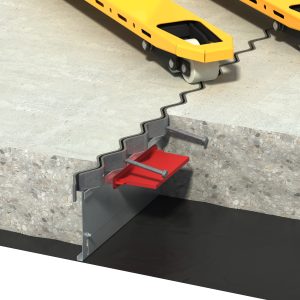The global warehousing sector has undergone a dramatic transformation in recent years driven by an explosion in e-commerce activity. Leviat’s Sales Director, Paul Whitehead, examines the growth in mega-warehouses, distribution, and logistics centres and what this means for the design and performance of industrial concrete floors that have become critical to their daily operations.

The aptly named ‘Amazon effect’ has altered the very concept of the traditional warehouse. The dramatic rise in e-commerce sales and online-only retailers coupled with customers’ demands for next or same day deliveries, has driven the need for large physical storage spaces that allow the rapid and smart processing of goods. It is estimated that 150,000,000 sq. ft of extra warehouse space will be needed by 2035 which is equivalent to 2160 football pitches or 1500 large warehouses.
Today’s mega-warehouses are being built near major transport arteries linking them to global transport networks. These mega-warehouses are open 24/7 with traffic movements a continuous feature. Not only do they cover a greater square footage than their predecessors, but they are also taller to account for the huge racking systems that automation has allowed for, such as automated packaging systems, shuttle systems, racking systems and automated picking tech. Drones can be seen flying overhead to carry out inventories whilst automated guided vehicles (AGVs) carry, receive and transport goods.
The operational intensity of the mega-warehouse has placed greater demands on concrete floor slabs, particularly at free movement joints. These slabs must be able to manage increased load capacities to avoid slab failure which would then require expensive remedial work. A busy dock loading area or aisle being closed for repeated maintenance in a 24/7-hour logistics operation can result in costly remedial work and operational downtime.
Prefabricated Joints
To address these demands, a wide range of approaches to joint design have emerged including engineered innovations such as Isedio ProGuardJoint, a prefabricated leave-in-place permanent joint former and load transfer system which can eliminate the impact load entirely, ensuring that Material Handling Equipment is always in contact with both sides of the joint as it is traversed. Designed specifically for high performance internal and external concrete floors, this system allows flooring contractors to cast fast and flat high performing concrete floors. It is used where a free movement joint is required but can be adapted to be used where a tied joint is required. Featuring a unique asymmetrical plate dowel design for superior load transfer, the system allows up to +/-20mm of longitudinal movement along the joint and 25mm maximum joint opening across all floor classes meeting the requirements of the Concrete Society’s TR34 (4th Edition) classifications.
Edge protection at joints is another critical area of development. This system provides heavy-duty reinforcement to slab panel edges by way of two back-to-back solid, high specification, cold drawn steel sections (40mm deep x 10mm wide). This solid steel edge protection is designed to prolong the life on any concrete floor. Slab edge protection is used only in the case of the formed free movement joints. These joints have edge protection to prolong the life of the exposed slab panel edges, as the slab panels shrink away from the joint during the curing process. Steel edge protection reinforces the edges of the slab panels against impact loads from mechanical handling equipment (MHE) or depending on joint design used, can eliminate the impact load entirely, ensuring that the MHE is always in contact with both sides of the joint as it is traversed.
Seamless Capabilities
Futureproofing a warehouse floor can offer long term operational benefits by providing the flexibility to change racking layouts to accommodate new product lines. Joint systems designed to minimise or eliminate dynamic loading when trafficked allow for a flexible layout of racks and ensures the floor remains seamless to the forklift driver. By investing in flexible jointing solutions at the outset, this can reduce the likelihood of remedial work and unwanted downtime.
Prefabricated joint solutions are typically manufactured in 3m lengths and may be supplied in a standard design or a bespoke design to suit a specific project’s requirements. For example, the divider plate which performs as a leave-in place formwork can be either designed as a fixed depth divider plate which is available in any size to suit a joint of 90mm upwards, or a two-part adjustable depth divider plate system that can be adjusted on site to the correct depth without the use of any tools.
Sealant-free Repairs
Increasing demands placed on existing warehouse concrete floors have led to a rise in the amount of damage to concrete either side of construction joints in medium to high traffic zones such as access doorways and dock loading areas. As a response, long-term repair solutions for damaged construction joints are now available without the need for traditional joint sealing. Certain designs incorporate a leave-in-place, sealant-free joint solution that prevents debris from entering the floor, thereby reducing ongoing maintenance needs and avoiding disruption to operations in busy logistics centres, warehouses, and factories.
Warehouse operations will continue to expand in both scale and complexity and so the performance of concrete floors will become a critical factor in ensuring a facility’s long-term functionality and efficiency. Innovations in joint design, such as prefabricated formers and load transfer systems to sealant-free repairs, can play their part in the operational resilience required by modern logistics facilities and safeguard against wear, downtime and costly repairs.













Recent Comments